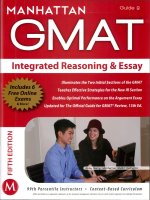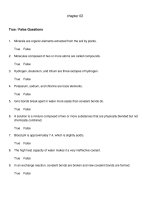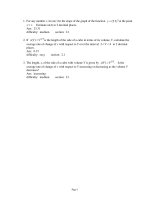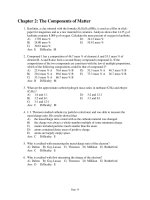Integrated reasoning and essay, 6th edition
Bạn đang xem bản rút gọn của tài liệu. Xem và tải ngay bản đầy đủ của tài liệu tại đây (4.12 MB, 143 trang )
MANHATTAN PREP
Integrated Reasoning & Essay
GMAT Strategy Guide
This guide covers the Integrated Reasoning and Argument Essay sections on the
GMAT. Master advanced new question type and discover strategies for optimizing
performance on the essay.
guide 9
Integrated Reasoning & Essay GMAT Strategy Guide, Sixth Edition
10-digit International Standard Book Number: 1-941234-04-6
13-digit International Standard Book Number: 978-1-941234-04-4
eISBN: 978-1-941234-25-9
Copyright © 2014 MG Prep, Inc.
ALL RIGHTS RESERVED. No part of this work may be reproduced or used in any form or by any means—graphic, electronic, or
mechanical, including photocopying, recording, taping, or web distribution—without the prior written permission of the publisher, MG
Prep, Inc.
Note: GMAT, Graduate Management Admission Test, Graduate Management Admission Council, and GMAC are all registered
trademarks of the Graduate Management Admission Council, which neither sponsors nor is affiliated in any way with this product.
Layout Design: Dan McNaney and Cathy Huang
Cover Design: Dan McNaney and Frank Callaghan
Cover Photography: Alli Ugosoli
INSTRUCTIONAL GUIDE SERIES
GMAT Roadmap
Number Properties
(ISBN: 978-1-941234-09-9)
(ISBN: 978-1-941234-05-1)
Fractions, Decimals, &
Percents
Critical Reasoning
(ISBN: 978-1-941234-01-3)
(ISBN: 978-1-941234-02-0)
Algebra
Reading Comprehension
(ISBN: 978-1-941234-00-6)
(ISBN: 978-1-941234-06-8)
Word Problems
Sentence Correction
(ISBN: 978-1-941234-08-2)
(ISBN: 978-1-941234-07-5)
Geometry
Integrated Reasoning & Essay
(ISBN: 978-1-941234-03-7)
(ISBN: 978-1-941234-04-4)
SUPPLEMENTAL MATERIALS
Math GMAT Supplement
Guides
Verbal GMAT Supplement
Guides
Foundations of GMAT Math
Foundations of GMAT Verbal
(ISBN: 978-1-935707-59-2)
(ISBN: 978-1-935707-01-9)
Advanced GMAT Quant
Official Guide Companion for Sentence
Correction
(ISBN: 978-1-935707-15-8)
(ISBN: 978-0-984178-01-8)
Official Guide Companion
(ISBN: 978-1-937707-41-5)
December 2nd, 2014
Dear Student,
Thank you for picking up a copy of Integrated Reasoning & Essay. I hope this book gives you just the
guidance you need to get the most out of your GMAT studies.
A great number of people were involved in the creation of the book you are holding. First and
foremost is Zeke Vanderhoek, the founder of Manhattan Prep. Zeke was a lone tutor in New York City
when he started the company in 2000. Now, well over a decade later, the company contributes to the
successes of thousands of students around the globe every year.
Our Manhattan Prep Strategy Guides are based on the continuing experiences of our instructors and
students. The overall vision of the 6th Edition GMAT guides was developed by Stacey Koprince,
Whitney Garner, and Dave Mahler over the course of many months; Stacey and Whitney then led the
execution of that vision as the primary author and editor, respectively, of this book. Numerous other
instructors made contributions large and small, but I'd like to send particular thanks to Josh Braslow,
Kim Cabot, Dmitry Farber, Ron Purewal, Emily Meredith Sledge, and Ryan Starr. Dan McNaney and
Cathy Huang provided design and layout expertise as Dan managed book production, while Liz
Krisher made sure that all the moving pieces, both inside and outside of our company, came together
at just the right time. Finally, we are indebted to all of the Manhattan Prep students who have given us
feedback over the years. This book wouldn't be half of what it is without your voice.
At Manhattan Prep, we aspire to provide the best instructors and resources possible, and we hope
that you will find our commitment manifest in this book. We strive to keep our books free of errors,
but if you think we've goofed, please post to manhattanprep.com/GMAT/errata. If you have any
questions or comments in general, please email our Student Services team at
Or give us a shout at 212-721-7400 (or 800-576-4628 in the U.S. or
Canada). I look forward to hearing from you.
Thanks again, and best of luck preparing for the GMAT!
Sincerely,
Chris Ryan
Vice President of Academics
Manhattan Prep
www.manhattanprep.com/gmat 138 West 25th Street, 7th Floor, New York, NY 10001 Tel: 212721-7400 Fax: 646-514-7425
TABLE of CONTENTS
1. How to Use This Guide
2. The Argument Essay
3. Introduction to Integrated Reasoning
4. Multi-Source Reasoning
5. Table Analysis
6. Graphics Interpretation
7. Two-Part Analysis
8. IR Strategies
Appendix A: How to Write Better Sentences
Appendix B: Quantitative Topics
Chapter
of 1
Integrated Reasoning
How to Use This Guide
In This Chapter…
The Essay
Integrated Reasoning
Chapter 1
How to Use This Guide
The Integrated Reasoning & Essay GMAT Strategy Guide will help you prepare for the Integrated
Reasoning (IR) and Analytical Writing Assessment (AWA, or Argument Essay) sections of the
GMAT.
We've put together this chapter to help you get the most out of this guide and any other resources you
use as you prepare for these two sections.
The Essay
The Argument Essay is the first section of the test as well as the least important. For most people, it's
sufficient to earn a score of 4 or higher (out of 6).
Because the essay section is first, it's important to make sure that you're prepared to score a 4 or
higher while expending the minimum necessary mental energy.
As a result, you have two main goals for your essay preparation:
1. Put yourself in a position to score 4 or higher.
2. Have a mental template in place to make it as easy as possible to write the essay.
For many, working through the essay chapter of this book will be enough to accomplish those two
goals. If you have access to our GMAT Interact™ for Essay lesson, you can use this resource in
addition to or instead of the essay chapter in this book.
If you are struggling to compose complex sentences, Appendix A of this book will teach you how to
write better sentences. This appendix is especially useful for anyone who doesn't have much practice
writing complex prose in English.
Test your skills on GMAC's GMAT Write™ program, the same software scoring system used on the
real exam. For a small fee, you'll get a score and feedback on two essays. You'll be able to revise the
essays and submit them again to see whether your score improves. If you're already in one of our
programs, check your program details; you might already have access to GMAT Write for free.
Integrated Reasoning
IR is the second section of the test. Most people will want to score a minimum of 5 or 6 (out of 8) on
this section.
The IR section also falls before the main event, Quant and Verbal, so you will again want to make
sure you're in a position to get a good enough score while not expending too much mental energy.
Start with Chapter 3, “Introduction to Integrated Reasoning,” to familiarize yourself with the timing,
scoring, and structure of this section, including the four types of IR problems.
Chapters 4–7 cover the four problem types, one per chapter. We've organized the chapters into what
we think is the best order in which to study the four types, but if you want to jump around, you can.
Later chapters do not build on or rely on the earlier ones.
Chapter 8 summarizes the strategies for each problem type and for the overall IR section. Appendix B
summarizes some of the decimals, percents, ratios, and statistics topics that are tested on the IR
section. For full treatment of these topics, see our Fractions, Decimals, & Percents GMAT Strategy
Guide and our Word Problems GMAT Strategy Guide.
Spread your IR study out over the full length of your GMAT preparation. For example, if you're
planning to study for 4 months in total, leave the final 2 weeks for a comprehensive review. Your
primary studies will therefore be spread over about 3.5 months. At this rate, you should plan to study
one IR question type, and complete all associated lessons and exercises, every 2.5–3 weeks.
As you finish a chapter, practice your skills using the online Question Banks that come with this
guide. If you purchase the The Official Guide for GMAT Review from GMAC® (the makers of the
GMAT), you'll have access to an additional online Question Bank of real IR questions from past
administrations of the GMAT. GMAC® also offers the IR Prep Tool, an additional online study tool
with a number of additional official IR problems.
If you're taking our course, then follow the syllabus that comes with the course. If you have access to
our online GMAT Interact for IR lessons, incorporate those into your studies as well. The interactive
modules are more detailed, so read the relevant chapter in this book first, then go through the
corresponding Interact lesson.
Finally, make sure to include the IR section when taking practice computer-adaptive tests (CATs).
You'll gain valuable practice under testing conditions and see whether you're making progress
towards your goal score. (If you take your first CAT before you start studying for IR, then you can
skip the IR section. After that, though, don't skip IR!)
You're ready to dive into the book. Good luck and happy studying!
Chapter
of 2
Integrated Reasoning
The Argument Essay
In This Chapter…
What Is the Argument Essay?
The Physical Mechanics of Essay Writing
What the Argument Essay Asks
How to Manage Your Time
How to Generate Good Ideas
How to Structure the Essay
How to Vary Sentence Structure and Content
Sample Essay
How to Prepare for the Essay
Additional Preparation
Chapter 2
The Argument Essay
The GMAT begins with its most open-ended task: the Analytical Writing Assessment (AWA), also
known as the Argument Essay, or just the essay. Whether you find this task straightforward or
challenging, you will need to familiarize yourself with this piece of the GMAT.
What Is the Argument Essay?
This section of the GMAT consists of one 30-minute essay that you type into the computer. In this
essay, you'll examine a flawed argument very similar to the flawed arguments you see on Critical
Reasoning (CR) problems.
The essay is separately scored—it does not factor into your general GMAT score (200–800). The
scale runs from 0 (lowest) to 6 (highest) in half-point increments. You'll be assessed on three sets of
skills:
1. Logical analysis: how well do you dissect and evaluate the argument?
2. Persuasive writing: how clearly and convincingly do you express your thoughts?
3. Language usage: grammar, syntax, variety of vocabulary
Chapter 11, “Analytical Writing Assessment,” of The Official Guide for GMAT Review describes the
essay task and provides a few useful example essays, as well as a list of possible essay topics and
other useful material. In an appendix, the Official Gudie also outlines the AWA scoring scale and
corresponding percentiles of a large set of recent test-takers.
AWA Score
Label
Percentile
6.0
Outstanding
92
5.5
5.0
81
Strong
4.5
4.0
44
Adequate
3.5
3.0
2.5
60
21
13
Limited
6
5
2.0
Seriously Flawed
1.5
1.0
3
Fundamentally Deficient
0.5
0.0
3
3
3
No Score
0
A 6.0 essay “presents a cogent, well-articulated critique of the argument and demonstrates mastery of
the elements of effective writing,” though there may still be minor flaws. At the other end of the
spectrum, No score means you've left the essay blank, written something off topic or in a language
other than English (including gibberish), or just recopied the topic.
Notice from the above chart that 79% of test-takers score “Adequate” (4.0) or better, while nearly
half (40%) score “Strong” (5.0) or better. Both a computer and a human (or two) grade your essay so,
unlike your other scores, you won't receive your AWA score until two to three weeks after your test,
when you receive your official score report from GMAC®.
What is the purpose of this essay in the admissions process?
It is not to distinguish exceptional performance from strong or even adequate performance. An
“Outstanding” essay will not improve your admissions chances more than a “Strong” essay will.
In a March 2011 research report, the GMAT folks admit that for the general population of applicants,
AWA scores add very little to the power of the GMAT and undergraduate grades to predict academic
performance in business school.
So why is this essay on the GMAT? To catch the bottom 20% of scores.
The schools want to ensure that you can write in English well enough to handle graduate-level
academic coursework conducted in English, particularly if you are a non-native-English speaker. This
essay is the only thing that schools know that you wrote completely on your own. The AWA score
provides admissions officers with a “Fine” or “Not Fine” on your ability to write in English.
If you score a 4.5 or higher, the schools will check off the “Fine!” box for you. If, on the other hand,
you score a 3.5 or lower, the schools will have concerns. They will likely review the actual text of
your essay in order to determine whether they think you can handle business-school-level
communications. (Note: if your score is fine, they won't bother to look at the essay text; in that case,
they'll just evaluate the essays you hand in as part of your application.)
In short, getting a low score (bottom 20%) on the essay can hurt your chances of admission.
Your goal on the essay is to clear the bar cleanly with a 4.5 or higher.
What about a 4.0? This score is probably fine for admission to any school. After all, a 4.0 is labeled
“Adequate.” If the rest of your scores are good, don't re-take the test just to lift your AWA score.
That said, if you're going to retake the GMAT anyway, put in a little more time on AWA preparation,
so that you clear the hurdle with a little more room. In addition, if you're at all worried about how
schools are going to perceive your facility with academic English, then a 4.5 or better can help set
your (and their) mind at ease.
If you are relatively confident that you'll score a 4.5 or higher, then you can do minimal preparation:
• Read the rest of this chapter and follow the instructions in “How to Prepare for the Essay.”
– Do GMAT Write™ (you'll learn what this is later in this chapter).
– Do the essay when taking practice computer-adaptive tests (CATs).
• Go in with a game plan. Know the process you want to follow.
• Write a decent amount. Longer essays generally score higher.
• Treat the essay as a warm-up, saving your energy for the rest of the GMAT.
However, if you think you're at risk of a score below a 4.0, then you've got more work to do. To
judge your risk, ask yourself these questions:
• Do you have little experience writing academic English?
– Did you rarely write essays in English in school?
– Were your grades in English classes low?
– In your job, do you rarely write anything longer or more formal than short emails?
• Is your command of written academic English weak?
If you're unsure, choose a long Reading Comprehension (RC) passage at random and read it
with no time pressure, then consider these questions:
– Are there many words that you didn't understand?
– Did you fail to understand sentences when they got too long?
– Did you take 10 minutes or more to finish the passage, only to find that you had little idea
what it meant?
– Did you frequently translate back into another language?
• Is your command of spoken English weak?
– Do you struggle to keep up with a conversation among native English speakers?
– Do you have a lot more trouble understanding English over the phone than in person?
– Do you frequently strain to formulate new or complex ideas in English?
If you answered “Yes” to several of these questions, read this chapter carefully and follow up with
Appendix A of this guide.
The Physical Mechanics of Essay Writing
You will be typing your essay into a text box on the computer screen. You can enter as much text as
you want, but you can only see about 10 lines at once.
The system feels like a clunky, old-fashioned word-processing program. You have just a few buttons
with standard functions:
Button
Function
Keyboard Shortcuts
Cut
Cuts text and puts it on a clipboard.
Ctrl-X or Alt-T
Copy
Copies text onto the clipboard.
Ctrl-C or Alt-C
Paste
Pastes text from the clipboard.
Ctrl-V or Alt-P
Undo
Undoes the last edit you made. You can
Ctrl-Z or Alt-U
undo your last 10 edits.
Redo
Redoes something you just undid. You
Ctrl-Y or Alt-R
can redo the last 10 undone actions.
Navigation keys on the keyboard act as you expect:
Arrow Keys move the cursor up, down, left, or right.
Enter and Return insert a paragraph bre ak and move you to a new line.
Page Up moves the cursor up one screen.
Page Down moves the cursor down one screen.
Backspace removes the character to the left of the cursor.
Delete removes the character to the right of the cursor.
Home moves the cursor to the beginning of the line.
End moves the cursor to the end of the line.
There is no underline, italic, or bold. Do not use any text-message substitutes (e.g., *asterisks* or
ALL CAPS). Rely on the words themselves to convey emphasis.
There is no tab or indent. To start a new paragraph, hit Return a couple of times to insert a blank line
between paragraphs. If you like to indent the beginning of paragraphs, hit the space bar a small,
consistent number of times (say, five).
There is no spell check or grammar check. Good spelling and grammar are better than bad spelling
and grammar, of course, so do your best in the moment to avoid mistakes, but don't labor excessively.
Follow spelling and grammatical rules well enough to make your meaning clear, but keep writing.
What the Argument Essay Asks
The Argument Essay asks you to analyze an argument—something with a conclusion and premises, as
you've learned on Critical Reasoning. In fact, your CR tools will come in handy as you tackle the
essay.
The argument that you need to analyze will contain a conclusion, or big claim, along with a few
premises. Here's an invented, slightly extreme example:
The country of Tarquinia has a much higher rate of traffic accidents per person
than its neighbors, and in the vast majority of cases one or more drivers is found
to be at fault in the courts. Therefore, Tarquinia should abolish driver-side
seatbelts, airbags, and other safety measures that protect the driver, while new
cars should be installed with a spike on the steering column pointed at the
driver's heart. These measures will eliminate traffic accidents in Tarquinia by
motivating drivers to drive safely.
Here, the conclusion is that these measures (abolishing driver-side safety measures and installing the
death spike) will eliminate traffic accidents in Tarquinia by motivating drivers to drive safely. The
premises are listed in the first sentence: the high rate of traffic accidents and the finding of driver
fault. The second sentence describes the proposed measures and can be seen as part of the
conclusion.
These are the official instructions for the essay:
Discuss how well reasoned you find this argument. In your discussion, be sure to
analyze the line of reasoning and the use of evidence in the argument. For
example, you may need to consider what questionable assumptions underlie the
thinking and what alternative explanations or counterexamples might weaken the
conclusion. You can also discuss what sort of evidence would strengthen or
refute the argument, what changes in the argument would make it more logically
sound, and what, if anything, would help you better evaluate its conclusion.
Let's break these four sentences down. The first sentence is the most important:
Sentence 1: Discuss how well reasoned you find this argument.
The argument will never be very well reasoned! Your goal is to find the flaws and explain them
clearly.
Sentence 2: In your discussion, be sure to analyze the line of reasoning and the use of evidence in
the argument.
Line of reasoning
• Does the conclusion follow completely logically from the premises? (No!) Why not?
• What and where are the gaps? Under what circumstances does the logic fail?
• What would help the author prove the conclusion?
Use of evidence
• Does the evidence truly prove what the author wants it to? (No!) Why not?
• What does the given evidence actually prove? Under what circumstances?
Sentence 3: For example, you may need to consider what questionable assumptions underlie the
thinking and what alternative explanations or counterexamples might weaken the
conclusion.
Questionable assumptions
• At each stage of the logic, what has the author assumed that is not necessarily justified?
Alternative explanations or counterexamples
• What else might explain the facts?
• What situations, cases, or circumstances has the author overlooked?
Sentence 4: You can also discuss what sort of evidence would strengthen or refute the argument,
what changes in the argument would make it more logically sound, and what, if
anything, would help you better evaluate its conclusion.
The last items listed in the instructions are worthwhile but less important. You can get a 6.0 without
including any of these aspects.
You are not asked to argue for or against the conclusion. Don't say whether you agree or disagree
with it. Rather, pretend a friend has asked you to vet his argument before he presents it to his boss.
Help him analyze the logical strength of his argument: how well the conclusion is supported by the
premises.
How to Manage Your Time
To write a decent essay in only 30 minutes, you'll need a clear process, such as the five-step one
below:
1. Read (1–2 min)
2. Brainstorm (2 min)
3. Outline (1–2 min)
4. Write (20 min)
5. Polish—a little (3–5 min)
Here's a short description of each step. You'll learn more about steps 2, 3, and 4 later in this chapter.
Step 1: Read (1–2 min)
First, clear your mind and read the argument slowly and carefully. Don't race through the reading.
Thirty minutes is not very long, but if you don't take time to understand the argument, you won't write
a very good essay.
As you read, identify the conclusion—the big claim that the author is making. The rest of the argument
typically consists of background information and premises—facts and smaller claims made to support
the conclusion. This support will always be flawed in some way and those flaws will be based on
gaps between the premises and the conclusion. Your job is to find those gaps.
Step 2: Brainstorm (2 min)
Some flaws will jump right out at you; others may take some thought. Jot your ideas on the scrap
paper or type them directly into the computer. Either way, don't write too much at this point—just
enough to remind you of your thoughts.
Step 3: Outline (1–2 min)
Type a short placeholder into the text box for each paragraph, including an introduction, some body
paragraphs, and a conclusion.
Step 4. Write (20 min)
Now go to town. The three scored examples in the Official Guide show a clear pattern:
Score
Word Count
6.0
335
4.0
260
2.0
108
The example of a 6.0 on mba.com (an essay that was actually written by a test-taker) has 599 words!
There's no need to write that much, but do write a decent amount. Aim for around 300 words.
Conveying complex information typically requires complex sentences. In fact, higher-scoring students
typically write longer sentences than lower-scoring ones:
Train yourself to write approximately 20 words a sentence, not as a strict measure to apply in every
case, but rather as a rough average. If you write 15 sentences averaging 20 words per sentence, you'll
have 300 words (though one very short sentence can really stand out when you have an important
point to make). Later in this chapter, you'll learn more about how to write better GMAT sentences.
Step 5. Polish—a Little (3–5 min)
With a few minutes to go, turn off the spigot. Glance back over what you've written and smooth out
the worst of the rough edges. Don't take too much time on any one sentence, gnawing your pen to find
the mot juste (the “perfect word” in French); you only need a good enough score on the essay. Don't
try to be Shakespeare.
In fact, if you're confident about the essay, you might want to finish a minute or so early. You don't get
a break before Integrated Reasoning, but you can make your own mini-break by finishing your essay
slightly early and then waiting to hit Submit. Don't worry—if you somehow don't actually hit the
button, what you've written will still be submitted.
During your self-made break, you won't be able to get up and walk around, but you are able to close
your eyes, take a few deep breaths, roll your shoulders, and massage your neck. The extra seconds
you take to manage your bodily state will do you good going into IR, which you will probably find
more challenging.
How to Generate Good Ideas
As mentioned earlier, you'll need to brainstorm several flaws from the argument.
The key to brainstorming is to follow a method, four of which are described below. Try them out and
use the method that works best for you.
Whichever method you use, jot down just enough to capture the idea; you don't have much time. Then
look for another idea. Here's how: imagine that the flaw that you just spotted is now fixed. What else
is wrong with the argument? Once you've identified three (or more) flaws, move to the outline phase.
Brainstorming Method 1: Line by Line
Start with the first sentence in the argument. What's wrong with it?
• If it's a piece of evidence, how does it fall short in proving the bigger point?
• If it's a claim, how is it not supported by the evidence?
Work your way, sentence by sentence, to the end of the argument.
Brainstorming Method 2: The CAST System
CAST is an acronym to remind you what you're looking for:
Counterexamples
• What situations would disprove the author's assertions?
Assumptions
• What is the author assuming, probably in an unjustified way?
Strengthen
• What would strengthen the argument?
Terms
• What specific words in the argument create logical gaps or other problems?
Go letter by letter through CAST and jot down ideas.
Brainstorming Method 3: Use the Instructions
You'll always be provided with the same instructions, so you can use them as a checklist. The first
sentence gives you the core task. The second sentence reminds you what to look at:
• Line of reasoning
• Use of evidence
The third sentence reminds you what to look for:
• Questionable assumptions
• Alternative explanations or counterexamples
Finally, the fourth sentence reminds you about other stuff you can add to your essay.
Brainstorming Method 4: Remember Common Fallacies
In the sample essay prompts (and in Critical Reasoning arguments, for that matter), many of the same









